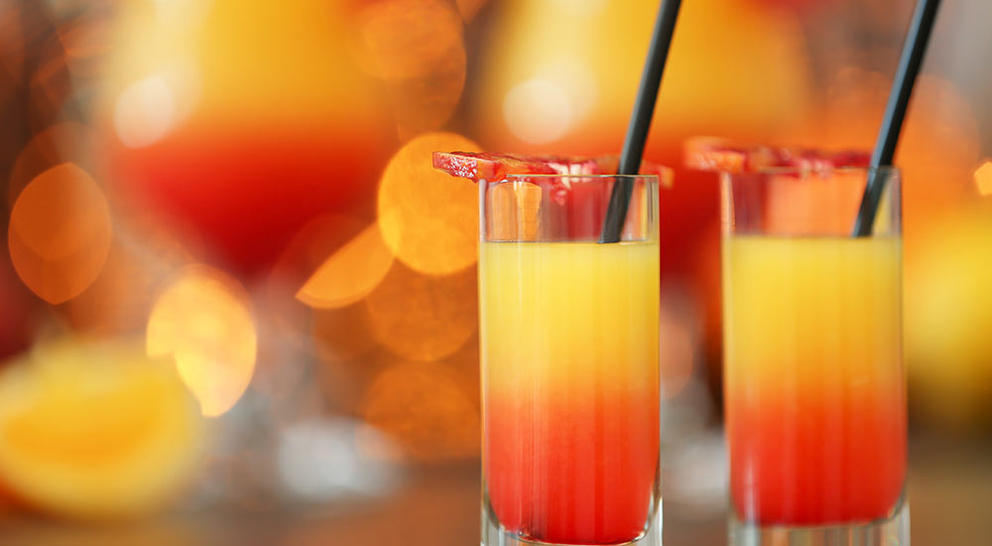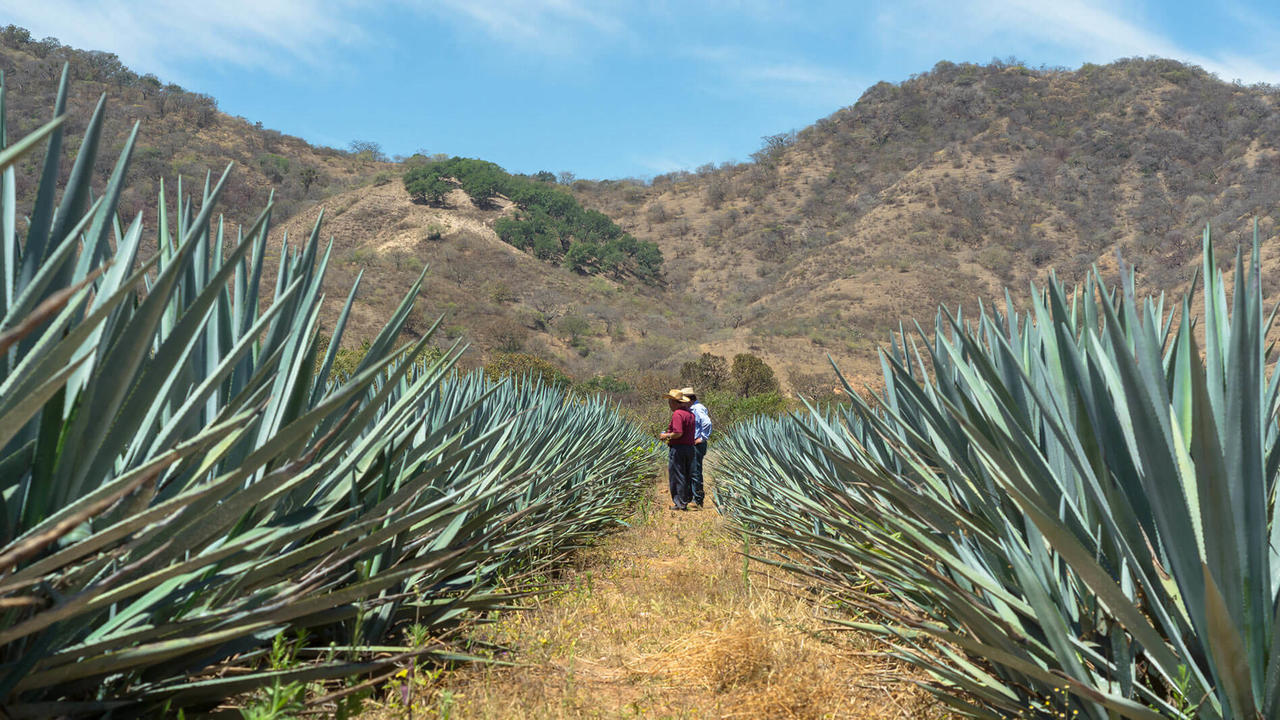Tequila is distilled from the juice of the abundant blue agave plant’s heart (known as the piña) and has become one of the most popular liquors in the world. While it’s the essential ingredient to the classic Margarita, it’s just as popular served 'neat' or even with a side of lime and salt.
Let's learn some more...
What is tequila?
Tequila is a distilled spirit from Mexico made from the blue agave plant. There are a variety of different tequila types with a long history behind them.

What is tequila made from?
Tequila is made from the blue agave plant and goes through an extensive process of production.
How is tequila distilled?

Now, let’s take a look at how the drink is distilled before it ends up in your Friday night Tequila Slammer. The key ingredient to tequila is the blue agave plant, pictured above.
Step 1: Pressing
First, the sugary juice of the blue agave plant is pressed out and extracted. This can be done by hand, but is more commonly accomplished by industrial presses or specific juicers and clamps.
Step 2: Fermenting
Next, the distinctive cactus juice is fermented for three or more days in stainless steel or wooden vats. The temperature slowly rises and the natural wild yeast converts the juice’s sugars into potent alcohol. The process is not done yet, though, because at this stage it’s only about as strong as wine or beer.
Step 3: Distilling
Now, we’re getting to the good part: distillation! This is where the Conquistadors’ European (and, before them, Arabic Moorish) influence helped take things to the next level. The copper still is introduced to distill the juice. The method from this point on can vary from distillery to distillery, but tequila is usually distilled from two to three times more, leading to a higher alcohol content (proof).
Step 4: Bottling
Lastly, the liquor is bottled up and cut with a small percentage of water to turn it into the drink made by today’s best tequila brands. The Tequila Regulatory Council (consejo regulador del tequila) will finally access the product and approve it for sale under '100% blue agave' and 'made in Jalisco'.
You might be wondering where the famous worm comes in? For brands that still use it, this is added right before the liquor is bottled.
Interested to know more about how is tequila made? Read all about it here on our expert page.
History of tequila

Tequila originated, unsurprisingly, in a Mexican town called Tequila. You can still find it today, roughly 40 miles outside of Guadalajara in the Jalisco state of Mexico.
Mexican tequila has been around since the 1500s, when the Spanish Conquistadors drank all of their brandy and decided they wanted more. They saw the stretching fields of blue agave plants and decided to use this as their ingredient for making alcohol.
It was not until some 80 years later that Don Pedro Sanchez de Tagle began to mass-distill the liquor in Jalisco, calling the drink 'tequila extract'. Don Cenobio Sauza (you’ll probably recognize his name from the still-popular Sauza brand of tequila) was the first to shorten the name to simply 'tequila'.
The spirit, whether tequila gold, tequila silver, is remarkably similar to the drink known as mezcal–in fact, the only true difference between tequila and mezcal is that for the production of tequila, the agave is boiled or steamed before starting the fermentation process.
However, we can't talk about tequila without mentioning its big papa, mezcal! They are two different spirits but made from the same ingredient (kind of). The mezcal vs tequila debate rumbles on to this day within Mexico. Flavour and production makes both spirits distinctly different from each other. But we couldn't talk about tequila and not mention this smoky relative!
Different types of tequila
There are many different types of tequila produced within the tequila industry. Here are the top three but click the link to get an in-depth overview of all the tequila types.
Blanco tequila (silver / plata)
Blanco tequila is characterised by being unaged. It’s bottled immediately (or within weeks) after it’s distilled. This is the 'harshest' variety of tequila with strong agave flavors, and is typically the most commonly used tequila for shots or cocktails. Tequila cocktails usually take this style due to its unique flavour and versatility.
Reposado tequila
Reposado translates to 'rested' in English (i.e. aged). This variety is aged for at least two months, but not more than a year in an oak barrel. Thus, reposado tequila takes on more of a woody, aged taste.
Añejo tequila
Añejo is an aged tequila. It's required that this variety of tequila is aged for over a year in small oak barrels or casks. This obviously lends tequila añejo tequila its distinctive oaky flavor.
Along the same lines, there’s also a recently-added category of high end tequila known as 'extra añejo' that must be aged for at least 3 years. This style is usually selected for sipping, rather than a cocktail ingredient.
Most popular tequila brands
Not too long ago, it was difficult to find much variety in tequilas outside of Mexico. Jose Cuervo and Sauza were the most commonly found brands worldwide.
The increased popularity of the spirit in the last few decades has been great for tequila lovers and producers. Patron is one of the most popular in the world and is reflected in its price tag, respectively. Tequila prices really vary from style to style and brand to brand, so research is always required before a purchase!
Fortunately, mid-range brands like Espolon, Coa, Quiote and the delicious El Jimador tequila reposado (a favorite of ours) are now readily available in bars and shops.
Depending on personal taste everyone has a different preference. The brands listed above are more than enough to get you started, however.
If you’re having trouble finding one that you like, ask yourself a few of the following questions:
- Do I like a crisp, bright taste, or do I prefer a mellower woody flavor? (For the former, choose a blanco tequila, for the latter, an añejo or extra añejo. For in-between, or if you’re not quite sure, it’s hard to go wrong with a good reposado.)
- What’s my budget? (If it's on the lower end, you’ll find more variety in the blanco or reposado category. Have some money to burn? A high-quality extra añejo tequila–just don’t drink it all at once!)

What to mix with tequila
Wondering what to mix with tequila? Nearly all citrus juices make excellent tequila mixers, as well as lemon lime sodas like Sprite, or grapefruit ones like Squirt.
However, if you’re drinking an añejo or extra añejo tequila, you’re drinking something closer to a nice Scotch whisky. This means that you don’t need much else to enjoy it, apart from a splash of soda water or a little bit of ice. Of course, there are always the classic tequila cocktails to enjoy tequila with!
However, whatever you're drinking, whether that's a tequila shot, Tequila Sunrise, or a tasty Margarita, remember that you’re not just drinking alcohol, you’re drinking a little piece of Mexican history!
Where is tequila made? Highland vs Lowland tequila

As with other alcohols, like wine and whiskey, tequila can also be influenced by geography. The characteristics of the land can heavily influence the characteristics of the tequila itself. Soil and weather conditions play their part in allowing every tequila distillery to produce a unique tequila. This can mean that tequilas of the same style have subtle differences based on its area of production.
In Jalisco, specifically, the debate exists around ‘highland’ and ‘lowland’ tequila. Within the state, tequila is grown in either one of these two areas. Tequila enthusiasts have long argued over which area produces the better tequila. However, it’s also disputed as to whether the geography plays any significant role in the tequila’s flavour at all. Nonetheless, it’s worth a short explanation…
Learn more about flavours and tasting tequila here.
Highland tequila
Named ‘los altos’ in Spanish, highland tequilas are said to be sweeter and fruitier, according to its enthusiasts. This area of tequila production is home to a richer soil, with intense floral notes. Highland tequilas pick up these sweet, rich flavours easily.
Lowland tequila
Those who are fans of lowland tequila (el valle), claim that these tequilas have much stronger flavours. The agave flavour is much stronger and is present alongside herbaceous, spicy, earthy and grassy notes. El valle is wetter and has much better access to water, hence the much earthier flavours.
Discover the highland and lowland tequila for yourself on our EBS Tequila and Mezcal Expedition.
Fancy a bit of extra reading? Discover the differences between liquor vs liqueur. Despite sounding similar, they're very different drinks, so come and learn all about it...
Want to work with tequila professionally and start making great tasting cocktails? Take a look into our bartender course and make the first move in your bartending career...

